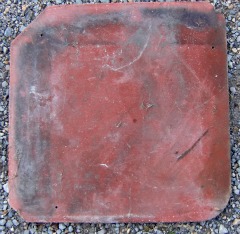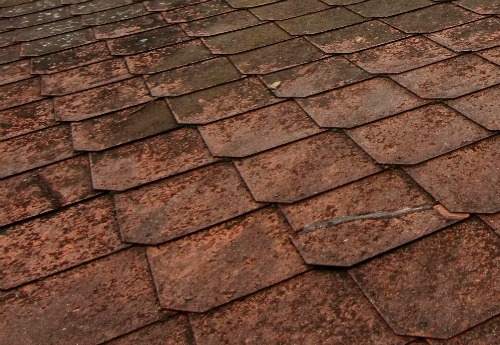My Asbestos Tile Roof
Asbestos tile is a type of roofing tile made up of a combination of Portland Cement and asbestos fibers and various fillers. This combination was first used in Europe in the 1870s. Manufacturing in the United States began in 1905. It is sometimes referred to as Transite tile.

Asbestos is a natural fiber. It is found in certain types of rock. While it sounds strange this fiber can be woven much like silk or cotton. Like any rock it resists burning. It is also extremely strong. With asbestos you could make a tile that was thin but much stronger than clay tile. It was less prone to cracking. The fibers did not absorb water. They did not swell. There were apparently no downsides to this wonder material.
The transite tiles found wide acceptance. Perhaps they would have dominated the market had the asphalt shingle come along. Asphalt shingles have the advantages of being flexible, and self-sealing. The asphalt shingles stick together and seal against the rain. Transite has the same problem as clay, slate and wood shingles. The shingles lay on top of each other but a strong wind can push water between the layers. Asphalt avoids this problem.
The downside of asbestos did not become public until the early 1970’s. It turns out that the unique asbestos fiber is also a major irritant to the lung. The body naturally reacts and coating and enscapsulating the fiber, but goes overboard. The body’s natural defenses end up clogging up the lungs with scar tissue. It is not a big deal if you breathed in a few fibers once or twice. The problem is breathing them in day in and day out over many years. This will seriously damage your lungs.
If you have an asbestos tile roof do not worry. These tiles will not release fibers into the air unless they are seriously damaged. Even then, if the fibers were to be blown away by the wind they would be too dispersed to cause a problem. The danger would be a bunch of tiles that are falling apart in some enclosed space like an attic. However, these tiles do not readily decay. Mine are over a hundred years old and still holding together. Where I have had tiles blown off by a storm the tiles had a clean break and there was not a problem with loose tiles.
If you have such a roof and need tiles there are companies that specialize in old roof tiles and you might be able to find a match. They will be costly, but perhaps cheaper than having to re-roof your house just because a few tiles were broken.
My roof showing a few signs of wear. Caulking the tile pieces back in place is one way to repair damaged tiles.
Your old roof also has some commercial value. If you ever need to replace your roof or tear down your house the tiles can be salvaged and sold to one of these antique tile companies. It is a great way to recycle, putting the good tiles back to use for their original purpose.
Unfortunately the transite tiles will not be manufactured again, at least not in the United States. The mining and manufacturing with asbestos is where the greatest danger of asbestos lies. The workers in these industries have often had their health ruined by the asbestos fibers lodging in their lungs.
When asbestos production was discontinued the asbestos tile companies tried to replace the fibers with other materials. Unfortunately nothing worked as well as asbestos, so no current product on the market can match the transite tile for its strength and thin profile.
To My Roof Underlayment Problem
To Vycor and Flexible Flashing
To My Roof Repair - First Page in Series
To My DIY Roofing - Continuation to Roof Repair
Please!





New! Comments
Have your say about what you just read! Leave me a comment in the box below.